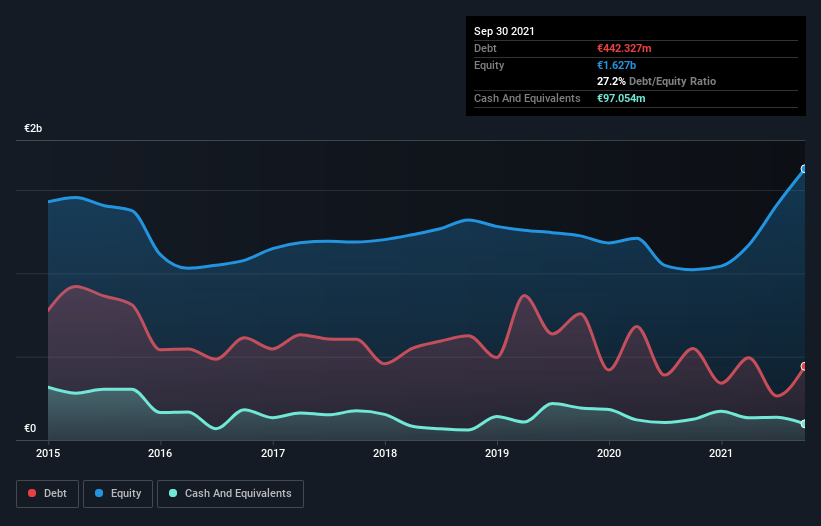
Howard Marks put it nicely when he said that, rather than worrying about share price volatility, 'The possibility of permanent loss is the risk I worry about... and every practical investor I know worries about.' So it might be obvious that you need to consider debt, when you think about how risky any given stock is, because too much debt can sink a company. As with many other companies Klöckner & Co SE (ETR:KCO) makes use of debt. But should shareholders be worried about its use of debt?
When Is Debt Dangerous?
Debt assists a business until the business has trouble paying it off, either with new capital or with free cash flow. Part and parcel of capitalism is the process of 'creative destruction' where failed businesses are mercilessly liquidated by their bankers. However, a more usual (but still expensive) situation is where a company must dilute shareholders at a cheap share price simply to get debt under control. Of course, debt can be an important tool in businesses, particularly capital heavy businesses. When we think about a company's use of debt, we first look at cash and debt together.
Check out our latest analysis for Klöckner & Co
How Much Debt Does Klöckner & Co Carry?
The image below, which you can click on for greater detail, shows that Klöckner & Co had debt of €442.3m at the end of September 2021, a reduction from €548.7m over a year. On the flip side, it has €97.1m in cash leading to net debt of about €345.3m.

How Healthy Is Klöckner & Co's Balance Sheet?
The latest balance sheet data shows that Klöckner & Co had liabilities of €1.31b due within a year, and liabilities of €720.3m falling due after that. On the other hand, it had cash of €97.1m and €1.05b worth of receivables due within a year. So its liabilities total €878.7m more than the combination of its cash and short-term receivables.
This deficit is considerable relative to its market capitalization of €1.02b, so it does suggest shareholders should keep an eye on Klöckner & Co's use of debt. This suggests shareholders would be heavily diluted if the company needed to shore up its balance sheet in a hurry.
We measure a company's debt load relative to its earnings power by looking at its net debt divided by its earnings before interest, tax, depreciation, and amortization (EBITDA) and by calculating how easily its earnings before interest and tax (EBIT) cover its interest expense (interest cover). Thus we consider debt relative to earnings both with and without depreciation and amortization expenses.
Klöckner & Co's net debt is only 0.48 times its EBITDA. And its EBIT covers its interest expense a whopping 69.5 times over. So we're pretty relaxed about its super-conservative use of debt. It was also good to see that despite losing money on the EBIT line last year, Klöckner & Co turned things around in the last 12 months, delivering and EBIT of €648m. There's no doubt that we learn most about debt from the balance sheet. But it is future earnings, more than anything, that will determine Klöckner & Co's ability to maintain a healthy balance sheet going forward. So if you're focused on the future you can check out this free report showing analyst profit forecasts.
But our final consideration is also important, because a company cannot pay debt with paper profits; it needs cold hard cash. So it's worth checking how much of the earnings before interest and tax (EBIT) is backed by free cash flow. Over the last year, Klöckner & Co reported free cash flow worth 14% of its EBIT, which is really quite low. That limp level of cash conversion undermines its ability to manage and pay down debt.
Our View
Even if we have reservations about how easily Klöckner & Co is capable of converting EBIT to free cash flow, its interest cover and net debt to EBITDA make us think feel relatively unconcerned. We think that Klöckner & Co's debt does make it a bit risky, after considering the aforementioned data points together. That's not necessarily a bad thing, since leverage can boost returns on equity, but it is something to be aware of. When analysing debt levels, the balance sheet is the obvious place to start. However, not all investment risk resides within the balance sheet - far from it. To that end, you should be aware of the 2 warning signs we've spotted with Klöckner & Co .
If you're interested in investing in businesses that can grow profits without the burden of debt, then check out this free list of growing businesses that have net cash on the balance sheet.
Valuation is complex, but we're here to simplify it.
Discover if Klöckner & Co might be undervalued or overvalued with our detailed analysis, featuring fair value estimates, potential risks, dividends, insider trades, and its financial condition.
Access Free AnalysisHave feedback on this article? Concerned about the content? Get in touch with us directly. Alternatively, email editorial-team (at) simplywallst.com.
This article by Simply Wall St is general in nature. We provide commentary based on historical data and analyst forecasts only using an unbiased methodology and our articles are not intended to be financial advice. It does not constitute a recommendation to buy or sell any stock, and does not take account of your objectives, or your financial situation. We aim to bring you long-term focused analysis driven by fundamental data. Note that our analysis may not factor in the latest price-sensitive company announcements or qualitative material. Simply Wall St has no position in any stocks mentioned.
About XTRA:KCO
Klöckner & Co
Distributes steel and metal products in Germany, Switzerland, France, the united states, and internationally.
Very undervalued with moderate growth potential.
Similar Companies
Market Insights
Community Narratives



